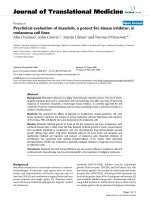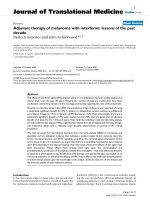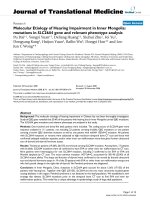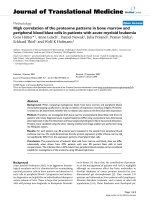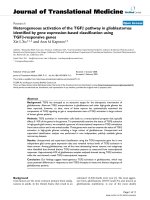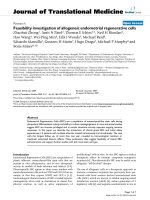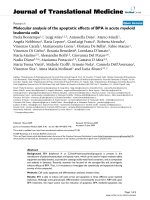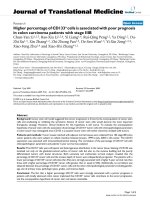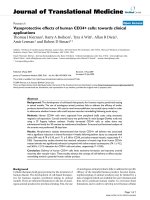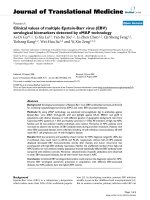Báo cáo hóa học: " “Hypoxia-induced down-regulation of microRNA449a/b impairs control over targeted SERPINE1 (PAI-1) mRNA - a mechanism involved in SERPINE1 (PAI-1) overexpression” pptx
Bạn đang xem bản rút gọn của tài liệu. Xem và tải ngay bản đầy đủ của tài liệu tại đây (2.55 MB, 14 trang )
Muth et al. Journal of Translational Medicine 2010, 8:33
/>
RESEARCH
Open Access
“Hypoxia-induced down-regulation of microRNA449a/b impairs control over targeted SERPINE1
(PAI-1) mRNA - a mechanism involved in
SERPINE1 (PAI-1) overexpression”
Michaela Muth1, Katharina Theophile1, Kais Hussein1, Christoph Jacobi2, Hans Kreipe1, Oliver Bock1*
Abstract
Background: In damaged organs tissue repair and replacement of cells by connective tissue provokes a response
of fibroblasts to cellular stress factors such as hypoxia.
MicroRNAs (miRNA) are small non-coding RNA molecules which bind to their mRNA targets which eventually lead
to repression of translation. Whether the response of fibroblasts to stress factors also involves the miRNA system is
largely unknown.
Results: By miRNA profiling we identified down-regulation of miRNA-449a/b expression in hypoxic fibroblasts.
Specific miRNA inhibitors and mimics showed direct evidence for targeting the serine protease inhibitor (serpin)
protein (SERPINE1; plasminogen activator inhibitor-1, PAI-1) by miRNA-449a/b leading to SERPINE1 mRNA and
protein up- and down-regulation, respectively. SERPINE1 expression in vivo could be located predominantly in areas
of fibrosis and remodeling.
Conclusions: Our study offers serious lines of evidence for a novel hypoxia-dependent mechanism involving
hypoxia-induced decrease of clustered miRNA-449a/b, hypoxia-induced amplification of concomitant increase of
targeted SERPINE1 (PAI-1) and its overexpression in tissues showing a hypoxic environment.
Background
Extracellular matrix (ECM) deposition and fibrotic
remodeling in damaged tissues is the principle to regain
integrity when affected tissues have no or only limited
capability for self-renewal [1]. Damage of tissues and
cells can be induced by hypoxia, infections and chronic
irritants but has in common that the response to injury
is very similar. Mechanisms of reparation will take place
after trivial wounding of the skin but are also demonstrable in organ transplantation when the allograft is
chronically rejected and compartments lose, step by
step, their function due to accumulation of ECM.
While hypoxia can cause damage and tissue destruction, the process of tissue repair and remodeling is also
accompanied by low oxygen levels in certain areas
* Correspondence:
1
Institute of Pathology, Hannover Medical School, Carl-Neuberg-Strasse 1,
30625 Hannover, Germany
causing a stress response of fibroblasts and other cell
types involved in tissue remodeling [2].
Tissue damage leads to accumulation of cytokines and
numerous growth factors like members of the transforming growth factor b family (TGF b 1-3) and bone
morphogenetic proteins (BMPs) [3-5]. Another set of
tissue remodeling factors belong to the family of matrixmetalloproteinases (MMPs) and their inhibitors TIMPs
(tissue inhibitors of metalloproteinases), [6,7]. Comparable with MMPs is the action of plasmin and members
of the plasminogen activator urokinase-type (uPA) and
-tissue-type (tPA) which mediate proteolysis of ECM
components but also activation of latent, inactive MMPs
[8,9]. Their negative regulator serine protease inhibitor
(serpin) protein (SERPINE1; plasminogen activator inhibitor-1, PAI-1) is an inhibitor of plasmin action and was
shown to be a target of TGFb-1 which implicates crosstalks between the members of the pro-fibrotic system
[10,11].
© 2010 Muth et al; licensee BioMed Central Ltd. This is an Open Access article distributed under the terms of the Creative Commons
Attribution License ( which permits unrestricted use, distribution, and reproduction in
any medium, provided the original work is properly cited.
Muth et al. Journal of Translational Medicine 2010, 8:33
/>
The microRNA (miRNA) system controls the fate of
mRNA molecules and stands for an important cellular
regulatory mechanism. Post-transcriptional regulation of
mRNA by the microRNA (miRNA) system is thereby
highly conserved among species, including humans, and
expression of hundreds of miRNA in tissues and cellular
lineages has already been reported [12]. Transcripts of
miRNA genes form ~ 100 nucleotide-long hairpin primary miRNA (pri-miRNA) precursors which are subsequently translocated from the nucleus to the cytoplasm.
They are further processed to shorter double-stranded
premature miRNA (~ 80 nucleotide-long pre-miRNA)
and finally to mature/functionally active ~ 20 nucleotide-short miRNA species [13]. A given biologically
active miRNA will then be incorporated into the
so-called RNA-induced silencing complex (RISC),
where binding of mRNA targets by miRNA takes
place. Semi-complementary binding of miRNA to the
3’-untranslated region (3’-UTR) of target mRNA results
in translational suppression or cleavage of mRNA,
respectively [13]. Due to these semi-complementary
miRNA-mRNA binding abilities, one miRNA might
control several potential mRNA targets and, vice versa,
one mRNA might be suppressed by several miRNA
species [12].
One particular miRNA was recently shown to be
involved in tissue remodeling and matrix deposition, i.e.
exclusive up-regulation of miRNA-21 by fibroblasts was
shown to be involved in myocardial fibrosis [14]. The
up-regulation of miRNA-21 was suggested to be stress
induced what attracted our attention because the stress
response of fibroblasts on the miRNA level has yet not
been accomplished.
We therefore investigated primary fibroblasts under
hypoxic stress, determined the miRNA profile, and
screened for designated mRNA targets involved in tissue
remodeling and fibrosis development. Lastly, we investigated tissues from kidney transplants showing chronic
remodeling for aberrations in miRNA expression and
impact on designated SERPINE1 mRNA and protein fate.
Methods
Cell lines and culture
Primary human fibroblasts (F-18, dermal origin, kindly
provided by Dr. Miriam Wittmann, Faculty of Biological
Sciences, University of Leeds, UK) and M15D [15] were
cultured as monolayers in RPMI 1640 containing 10%
fetal calf serum (FCS) and 1% antibiotics until subconfluence. Metaphase cytogenetics showed no evidence for
clonal aberrations in these primary cell lines.
Hypoxia in cell culture
Cell culture flasks were placed into anaerobic jars for 24
hours (Anaeropack for cell culture, Mitsubishi Gas
Page 2 of 14
Chemicals, Tokyo, Japan) to induce hypoxic culture
conditions as described [16,17]. Briefly, the Anaeropack
for Cell contains sodium ascorbate as the principal
ingredient which absorbs oxygen and generates carbon
dioxide by oxidative degradation. Magnesium hydroxide
is used as a scavenger for carbon dioxide. These
reagents are located in paper sachets and are placed
into the jars. Controls were cultured in parallel under
normal oxygen concentration of ~ 20%. Viability tests of
cells in culture were performed before and after 24
hours by Trypan blue exclusion.
Transfection of fibroblasts with miRNA-449 inhibitors
and miRNA-449 mimics
The HiPerfect Transfection Reagent (# 301705, Qiagen,
Hilden, Germany) was used for transfection with antihsa-miRNA-449a/b Inhibitor (#MIN0001541, target
sequence UGG CAG UGU AUU GUU AGC UGG U;
#MIN0003327, target sequence AGG CAG UGU AUU
GUU AGC UGG C; respectively, both Qiagen, Hilden,
Germany) or with Syn-hsa-miRNA-449a/b Mimic
(#MSY0001541, target sequence UGG CAG UGU AUU
GUU AGC UGG U; #MSY0003327, target sequence
AGG CAG UGU AUU GUU AGC UGG C; respectively,
both Qiagen, Hilden, Germany). A negative control
siRNA (#1027280; Qiagen, Hilden, Germany) was transfected as well. This control has no homology to any
mammalian gene. Additionally, primary fibroblasts were
treated with the HiPerfect Transfection Reagent only.
Transfection was performed according to the manufacturer’s protocol for adherent cells in 6-well plates
with 2 different concentrations as follows: miRNA
inhibitor 50 nM and 100 nM; miRNA mimic 5 nM
and 10 nM, respectively. After transfection cell culture
flasks were placed into anaerobic jars for 24 hours.
Controls were cultured in parallel under normal oxygen tension.
Human tissue specimens
From the archive of the Institute of Pathology, Hannover Medical School, we retrieved formalin-fixed, paraffin-embedded (FFPE) tissues and biopsies from
kidney transplants (n = 5) showing proven histopathological features of chronic allograft nephropathy with
interstitial fibrosis, glomerular and tubular atrophy
accompanied by only a mild chronic inflammation.
Control samples (n = 4): 2 different tissue specimens
from 1 kidney transplant immediately explanted due to
allograft-steal syndrome, 3 tissue specimens taken from
3 tumor nephrectomies due to renal cell carcinoma.
These control specimens showed normal kidney morphology and no evidence for involvement by carcinoma. Relevant clinical and morphological information
are listed in Table 1.
Muth et al. Journal of Translational Medicine 2010, 8:33
/>
Page 3 of 14
Table 1 Condensed data on patients histories and sample type
Gender
Age
Underlying
disease
Year
of
Tx.
Kidney
explant
or
biopsy
Why
indicated?
Histopathological
diagnosis
Tissue
samples
analyzed
n=
Symbol#in
Figure 8
female
60
Systemic Lupus
erythematosus
1999*
Kidney
explant
(01/2007)
Acute
renal failure
(Interstitial fibrosis, tubular
atrophy)
Banff 2007,
5. II [34]
2
Black circle
Black
square
female
41
Systemic vasculitis (Purpura
Schoenlein-Henoch)
1996
Kidney
explant
(01/2007)
Acute
renal failure
(Interstitial fibrosis, tubular
atrophy)
Banff 2007,
5. II [34]
1
Black
triangle
male
17
Obstructive
uropathy
2006*
Kidney
explant
(08/2007)
Impaired
kidney
function
(Interstitial fibrosis, tubular
atrophy)
Banff 2007,
5. III [34]
2
Black
reverse
triangle
Black
rhomb
female
45
Chronic glomerulo-nephritis
1996
Indication
biopsy
(04/2007)
Impaired
kidney
function
Chronic tubulo-interstitial
injury,
evidence for calcineurin
inhibitor
toxicity (CNIT)
1
White
circle
male
72
Chronic interstitial nephritis
2007
Indication
biopsy
(06/2007)
Impaired
kidney
function
Interstitial fibrosis, tubular
atrophy, vasculopathy)
Banff 2007,
5. II [34] **
1
White
square
female
42
Systemic Lupus
erythematosus
2005
Kidney
explant
(2005)
Allograft-stealsyndrome
Diffuse tubular
damage
2
Black
circles
in plot
“Control”
Not known
(anonymized)
RCC
RCC
Tumor
n.a. nephrectomy
RCC
RCC
RCC
RCC
1
Normal
1
1
2 allograft in patients history, ** = “old-for-old” kidney allocation, Tx. = transplantation, RCC = renal cell carcinoma, n.a. = not attributable. #Two symbols per
case mean that 2 different tissue blocks were analyzed in the same patient.
nd
RNA extraction
The monolayer of 1 culture flask (75 cm 2 ) was suspended in 1 ml TRIZOL Reagent (Invitrogen, Carlsbad,
CA, USA) and stored over night at -20°C. The extraction of total RNA was accomplished as instructed by the
manufacturer. Total RNA was extracted from FFPE tissues following guanidinium isothiocyanate/Proteinase
K-based digestion, and conventional organic extraction
using phenol/chloroform as we previously described
[18].
cDNA synthesis
The TaqMan MicroRNA Reverse Transcription Kit (Part
No. 4366596, Applied Biosystems, Foster City, CA, USA)
and the Megaplex™ RT Primer A (Megaplex™ RT Primers, Human Pool A, Part No. 4399966, Applied Biosystems, Foster City, CA, USA) were used to synthesize
complimentary DNA (cDNA) for the TaqMan MicroRNA Array (TaqMan® Human MicroRNA A Array v2.0,
Part No. 4398965, Applied Biosystems, Foster City, CA,
USA). The final reverse transcription reaction consisted
of 3.0 μL 500 ng total RNA and 4.5 μL RT reaction mix.
cDNA was synthesized as described in the manual of
Run Megaplex™ Pools without pre-amplification
(Applied Biosystems, Foster City, CA, USA).
The TaqMan MicroRNA Reverse Transcription Kit
(Part No. 4366596, Applied Biosystems, Foster City, CA,
USA) was also used to synthesize cDNA for the individual TaqMan MicroRNA Assays (RNU48 Assay ID
001006, RNU49 Assay ID 001005, hsa-miRNA-449a
Assay ID 001030, hsa-miRNA-449b Assay ID 001608,
Applied Biosystems, Foster City, CA, USA) by using
0.01 μg total RNA. For real-time RT-PCR on the mRNA
level the High Capacity cDNA Reverse Transcription Kit
(Part No. 4368814, Applied Biosystems, Foster City, CA,
USA) was applied by using 1 μg total RNA.
MicroRNA profiling
The TaqMan Human MicroRNA A Array v2.0 represents a 384-well format (Part No. 4398965, Applied Biosystems, Foster City, CA, USA). 377 human miRNAs,
three endogenous controls and one negative control
Muth et al. Journal of Translational Medicine 2010, 8:33
/>
were included. The array was loaded with a mixture of
450 μL TaqMan Universal PCR Master Mix, No
AmpErase UNG (Part No. 4324018, Applied Biosystems,
Foster City, CA, USA), 6 μL Megaplex RT product and
444 μL HPLC-H2O. The TaqMan Human MicroRNA A
Array was performed on a 7900HT Fast Real-Time PCR
system and was recorded by the 7900HT SDS 2.3 software (Applied Biosystems, Foster City, CA, USA). Only
miRNA showing at least 3-fold increase or decrease
were included in the results section. LDA data of
miRNA expression are shown in the additional file 1.
Gene expression profiling by custom made low
density arrays
A set of 45 genes related to tissue remodeling and fibrosis and 2 reference genes (RNA-polymerase 2 - POLR2A
and b-Glucuronidase - GUSB) was selected for custom
made TaqMan Low Density Arrays (LDA; Applied Biosystems, Foster City, CA, USA). Details of the genes
spotted on the LDA are shown in the additional file 2.
The reference gene Glyceraldehyde-3-phosphate dehydrogenase (GAPDH) was declared to be mandatory on
LDA according to the distributor but due to the well
known up-regulation of GAPDH by hypoxia it was not
considered as a reference gene for subsequent relative
quantification. The entire gene set was spotted 8-fold
(8 × 48) on the 384-well micro fluidic card allowing
concomitant investigation of 8 samples per run. The
array was loaded with a mixture of 5 μL cDNA, 45 μL
HPLC-H2O (J.T. Baker, Phillipsburg, NJ, USA) and 50
μL Universal PCR Master Mix (Part No. 4352042,
Applied Biosystems, Foster City, CA, USA). TaqMan
low density arrays were performed on a 7900HT Fast
Real-Time PCR system and recorded by the 7900HT
SDS 2.3 software (Applied Biosystems, Foster City, CA,
USA). Only genes showing at least 3-fold up- or downregulation were included in the results section. LDA
data of mRNA expression are shown in the additional
file 1.
Re-evaluation of miRNA and mRNA targets
The expression of hsa-miRNA-449a (ID 001030) and
hsa-miRNA-449b (ID 001608) along with reference small
RNA molecules RNU48 (ID 001006) and RNU49 (ID
001005) was re-evaluated by real-time PCR (TaqMan
7500 Fast Real-Time PCR system, Applied Biosystems).
Each reaction consisted of 10 μL TaqMan Universal PCR
Master Mix, No AmpErase UNG (Part No. 4324018,
Applied Biosystems, Foster City, CA, USA), 1 μL of the
invidual TaqMan MicroRNA Assay (Applied Biosystems,
Foster City, CA, USA), 4 μL HPLC-H 2 O (J.T. Baker,
Phillipsburg, NJ, USA) and 5 μL cDNA.
The re-evaluation of SERPINE1 mRNA expression was
performed with 2 different assays (Hs01126606_m1,
Page 4 of 14
Hs00167155_m1, respectively, Applied Biosystems, Foster City, CA, USA) in addition to POLR2A
(Hs00172187_m1) and GUSB (Hs99999908_m1) as
reference genes in 20 μL reactions containing 10 μL
TaqMan Gene Expression Master Mix, 1 μL of the individual TaqMan Gene Expression Assay (both Applied
Biosystems), 8 μL pure water, and 1 μL cDNA.
Quantification of real-time PCR data
Recorded C T values were converted into ΔC T values
relative to reference genes POLR2A and GUSB for
mRNA and RNU48 and RNU49 for microRNA, respectively. The 2 -ΔΔCT method [19] was applied by using
Excel 8.0 (Microsoft, Redmond, WA, USA). Results
were statistically analyzed and graphically visualized
with Prism 5.0 (GraphPad Software, San Diego, CA,
USA) by applying the one-way analysis of variance
(ANOVA) test followed by Tukey’s post-test.
Immunocytochemistry and immunohistochemistry
F-18 and M15D were transfected as described and cultured as monolayers on 4-well chamber slides (Nalge
Nunc, Naperville, IL, USA) under hypoxia for 24 hours.
Primary human fibroblasts were treated with the HiPerfect Transfection Reagent only and cultured under normal oxygen tension. Fixation was carried out in ice-cold
acetone for 10 minutes followed by air-drying and rehydration in PBS. The chamber slides were incubated for
1 h with the mouse monoclonal anti-human SERPINE1
antibody raised against amino acids 1 - 250 of the
mature protein (1:50 dilution; TJA6, sc-59636, Santa
Cruz Biotechnology Inc., Santa Cruz, CA, USA). For
visualization the ZytoChem Plus HRP Polymer-Kit
(Zytomed Systems, Berlin, Germany) and the DAB Substrate Kit High Contrast (Zytomed) were used. Counterstaining was accomplished with haematoxylin.
Immunohistochemistry on human kidney tissue was
performed on tissue sections (1 - 2 μm) which were
deparaffinised and treated with 3% H 2 O 2 for 10 min.
Following pre-treatment in a pressure cooker for retrieval of antigens, sections were incubated for 1 hour with
the antibody against SERPINE1. Positive control for
SERPINE1 was human placenta tissue and an isotype
control monoclonal antibody (1:100 dilution, negative
control for mouse IgG 1 Ab-1, clone NCG01, DLN05791, dianova, Hamburg, Germany) was used as negative control in lieu of the primary antibody.
Results
Hypoxia induced down-regulation of miRNA in primary
fibroblasts
MicroRNA profiling determined that only 3 out of 377
miRNA subtypes were down-regulated in primary fibroblasts under hypoxic conditions compared with primary
Muth et al. Journal of Translational Medicine 2010, 8:33
/>
fibroblasts cultured under normal oxygen concentration:
miRNA-449a (median -10.2, range -9.1 up to -11.3,
p < 0.001), miRNA-449b (median -2.6, range -1.4 up to
-3.8) and miRNA-518a-3p (median -5.1, range -2.3 up
to -7.9, p < 0.01), Figure 1.
Re-evaluation in an independent experimental setting confirmed down-regulation of miRNA-449a
(median -4.0, range -2.9 up to -5.0, p < 0.01) and
miRNA-449b (median -3.6, range -2.3 up to -4.9,
p < 0.01), Figure 2.
SERPINE1 is the most up-regulated gene in primary
fibroblasts cultured under hypoxic conditions
Hypoxia induced overexpression of 10 target genes compared with gene expression profiling under normal oxygen conditions: Among those, SERPINE1 was
significantly overexpressed by up to 10-fold (p < 0.001).
Other inducible factors were COL4A3, LOX, PLAT,
PLAUR, PLOD2, EDN1, GAPDH and inhibitors of
matrix remodeling NOG and TIMP1. BMP6 and
FOXP3 were down-regulated (Figure 3).
Page 5 of 14
Target prediction for miRNA-449a/b revealed SERPINE1
mRNA as a candidate
From the hypoxia-induced set of aberrantly expressed
genes in fibroblasts (Figure 3) we screened for those
potentially targeted by miRNA-449a/b. The TargetScan
Database ( Wellcome Trust Sanger Institute) revealed SERPINE1 as a
predicted target for both miRNA-449a and miRNA449b (additional file 3 A + B).
SERPINE1 overexpression in fibroblasts was then reevaluated with 2 different commercially available gene
expression assays following hypoxic culture in 3 independent experiments. Both assays confirmed SERPINE1
overexpression compared with normal oxygen conditions (median 5.3, 8.0, respectively), Figure 4.
Hypoxia-driven inhibition and mimicking of miRNA-449
revealed direct targeting of SERPINE1 mRNA in vitro
Transfection followed by culture under hypoxic conditions induced increase and decrease of miRNA-449a/b
by inhibition and mimicking, respectively. Inhibition
Figure 1 MiRNA profiling and identification of candidates in fibroblasts under hypoxia. MiRNA profiling of a total of 377 different miRNA
species revealed down-regulation of miRNA-449a, -449b and -518a-3p when primary fibroblasts were cultured under hypoxic conditions (relative
to RNU48). Shown are results from cell line F-18. *** = p < 0.001, ** = p < 0.01 (two independent experiments).
Muth et al. Journal of Translational Medicine 2010, 8:33
/>
Page 6 of 14
Figure 2 Re-evaluation of miRNA-449a and miRNA-449b in fibroblasts. Three independent experiments confirmed significant
down-regulation under hypoxia. All calculations were performed relative to RNU48 in the cell line F-18. ** = p < 0.01.
Figure 3 Gene expression profiling in fibroblasts under hypoxia. Primary human fibroblasts were analysed by LDA designed to determine
fibrosis- and ECM-related gene expression. Depicted are the mean and range of gene expression in fibroblasts under hypoxia relative to
reference gene POLR2A. Shown are results from cell line F-18. Among other factors induced in the hypoxic culture SERPINE1 mRNA was
increased 10-fold. *** = p < 0.001, ** = p < 0.01 (two independent experiments).
Muth et al. Journal of Translational Medicine 2010, 8:33
/>
Page 7 of 14
Figure 4 Re-evaluation of SERPINE1 mRNA expression in fibroblasts under hypoxia. Two different gene expression assays were applied to
confirm SERPINE1 overexpression relative to POLR2A in fibroblasts cultured under hypoxia compared with fibroblasts cultured under normal
oxygen conditions. Shown are results from cell line F-18. * = p < 0.05 (three independent experiments).
showed down-regulation of miRNA-449a by up to 23fold and 15-fold, for miRNA-449b by up to 26-fold and
27-fold (50 nM, 100 nM, respectively). Mimicking
increased miRNA-449a by up to 8-fold and 15-fold, for
miRNA-449b by up to 6-fold and 4-fold (5 nM, 10 nM,
respectively), Figure 5.
In a next step fibroblasts were studied for SERPINE1
mRNA expression under the similar experimental setting. When transfection studies were performed under
hypoxia an increase of SERPINE1 mRNA by up to 8.0fold (miRNA-449a inhibition: median 7.2, range 6.5 to
8.0; miRNA-449b inhibition: median 7.1, range 6.2 to
8.5) could be demonstrated compared with non-transfected cells cultured under hypoxia. Mimicking of
miRNA-449a/b reversed SERPINE1 mRNA level thereby
providing direct evidence for a targeting of SERPINE1
mRNA by miRNA-449a/b, Figure 6. The effects shown
for SERPINE1 targeting by miRNA-449a/b were exclusively demonstrable in the hypoxic state of cell culture.
Inhibition and mimicking of miRNA-449 affected
SERPINE1 protein expression in fibroblasts
Following transfection with miRNA-449a inhibitor fibroblasts were cultured under hypoxic conditions and
showed a strong induction of SERPINE1 protein (Figure
7A + B). By contrast, miRNA-449a mimics (Figure 7C +
D) showed almost no SERPINE1 protein expression
whereas control fibroblasts showed a faint SERPINE1
staining (Figure 7E + F).
Chronic allograft remodeling showed the inverse
expression of miRNA-449a/b and SERPINE1 expression
In human kidney transplants showing chronic allograft
remodeling, miRNA-449a and miRNA-449b were downregulated by up to 17.0-fold (median -7.8, range -2.5 to
-16.6, p < 0.001) and 95.0-fold (median -23.3, range 2.3
to -95.4, p < 0.05), respectively (Figure 8 B + C). SERPINE1 mRNA expression in these specimens were
increased by up to 37.0-fold (median 15.62, range 3.2 to
Muth et al. Journal of Translational Medicine 2010, 8:33
/>
Page 8 of 14
Figure 5 MiRNA-449a/b expression under hypoxia. Primary human fibroblasts were transfected with miRNA-449a/b inhibitor or miRNA-449a/
b mimics and were cultured under hypoxia. Inhibition or mimicking strongly decreased or increased miRNA-449a/b expression, respectively.
Depicted are calculations relative to reference gene RNU48 compared with non transfected cells cultured with hypoxia. Negative control means
cells transfected with negative control siRNA only. Results are shown for cell line F-18 but were likewise demonstrable in M15D. * = p < 0.05
(three independent experiments).
37.2, p < 0.01) when compared to control kidneys,
Figure 8A.
SERPINE1 protein in kidney tissues was predominantly demonstrable in areas of interstitial fibrosis and
vascular remodeling. Activated fibroblasts and smooth
muscle cells were labeled. Glomerula and atrophic tubuli
remodeled by connective tissue were also strongly
stained (Figure 9A + B). Control kidney affected by
acute diffuse tubular damage showed a heterogenous
pattern with some strongly labeled proximal tubuli
whereas other compartments were almost unlabelled.
Some smooth muscle cells in smaller arterial vessels
were also stained for SERPINE1 (Figure 9, C + D).
Discussion
Uncontrolled tissue remodeling affects organ function, e.
g. leads to dysfunction in transplanted organs. Acute tissue damage and wounding but also consecutive tissue
repair and remodeling create a hypoxic environment
and provide an appropriate condition for changes in
gene expression due to hypoxia-sensitivity [20]. The
fibroblast is the leading cell type involved in production
of ECM following an adequate stimulus, i.e. one single
activated fibroblast is able to induce thousands of procollagen molecules per minute [21]. It is the nature of
tissue repair and remodeling that numerous factors and
environmental conditions act in concert to guide the
restoration process such as expression of hypoxia-inducible factors (HIF) and their target genes but also
growth factors which induce a pro-fibrotic response [1].
Accordingly, at a glance it appears unlikely that a single
aberration is predominantly involved in abnormal tissue
remodeling. However, it has recently been shown by a
decisive study that overexpression of miRNA-21 in
fibroblasts is involved in myocardial fibrosis [14] suggesting that stress signaling could affect miRNA
expression.
We found by miRNA profiling that only 3 out of 377
miRNA subtypes were down-regulated in primary fibroblasts when the stress factor hypoxia was tested. A single miRNA, i.e. the miRNA-184 was up-regulated (data
not shown). The profiling showed no notable up-regulation of miRNA-21 in our approach. Previous work in
cancer cell lines showed a much stronger affection by
Muth et al. Journal of Translational Medicine 2010, 8:33
/>
Page 9 of 14
Figure 6 SERPINE1 mRNA level in fibroblasts under hypoxia. Transfection of miRNA-449a/b inhibitors and miRNA-449a/b mimics targeted
SERPINE1 mRNA under hypoxic culture conditions. The mimicking of miRNA-449a/b reversed SERPINE1 mRNA to baseline level. Depicted are
calculations relative to reference gene POLR2A compared with non-transfected cells cultured under hypoxia. Negative control means cells
transfected with negative control siRNA only. SERPINE1 mRNA induction through hypoxia alone and without additional transfection of miRNA449 inhibitors or miRNA-449 mimics is indicated by the dotted line (cell line F-18). ** = p < 0.01 (three independent experiments).
hypoxia with numerous miRNA being up- or downregulated [22,23]. This difference can be explained by
the fact that the basic miRNA profile in carcinoma cells
is apparently much more aberrant than in normal cells
and furthermore likely to be amplified by additional
stress factors such as hypoxia.
We used only Pool A and therefore only 377 miRNA
for profiling because trials in our lab using also Pool B
showed very low numbers of detectable miRNA in different tissues and cell lines tested.
We selected the clustered miRNA subtypes miRNA449a/b for confirmatory experiments in hypoxic fibroblasts because this decrease should lead to up-regulation
of certain mRNA targets in this setting. Additionally,
due to the immediate availability of low-density arrays
designed to reveal important players in the pathogenesis
of myelofibrosis [24] we performed gene expression profiling in hypoxic fibroblasts. Among other up-regulated
factors involved in ECM synthesis and remodeling
including HIF-1a targets LOX, EDN1 and GAPDH,
SERPINE1 showed the strongest induction by up to
10-fold.
In the next step we asked if one of these hypoxiainducible factors could be regulated by miRNA-449a/b.
The miRBase Target Database (by using the link for
TargetScan) listed SERPINE1 as a putative mRNA target
of miRNA-449a/b.
We then tested the functional relationship between
SERPINE1 and miRNA-449a/b by transfection of fibroblasts with miRNA-449 inhibitors or the respective
mimics. SERPINE1 mRNA strongly increased through
miRNA-449 inhibition while miRNA-449 mimics
restored to baseline SERPINE1 mRNA levels. Of note,
targeting of SERPINE1 mRNA by miRNA-449a/b was
only demonstrable when hypoxia was present.
Though an increase of SERPINE1 could easily be
explained by induction through HIF-1a the experiments
using miRNA-449a/b mimics definitely support our proposed mechanism because these mimics induced a
decrease of SERPINE1 mRNA level. Accordingly, labeling of SERPINE1 protein in these cell cultures confirmed a strong SERPINE1 protein expression when
miRNA-449a was inhibited. When miRNA-449a was
mimicked, almost no staining was demonstrable.
Muth et al. Journal of Translational Medicine 2010, 8:33
/>
Page 10 of 14
Figure 7 Immunocytochemistry of primary human fibroblasts (F-18) transfected with miRNA-449a inhibitor or miRNA-449a mimics.
SERPINE1 strongly marked the fibroblasts transfected with miRNA-449a inhibitor (Figure 7 A + B) compared to miRNA-449a mimics which
virtually blocks SERPINE1 protein expression (Figure 7 C + D). Non transfected primary human fibroblasts cultured under hypoxia showed
SERPINE1 protein labeling in some cells (Figure 7 E + F). DAB immunostaining with mAb against SERPINE1 protein counterstained with
haematoxylin. Magnification in Figure 7 A, C, E: 100×; Figure 7 B, D, F: 200×; brown: SERPINE1 positive fibroblasts; blue: nuclei (two independent
experiments).
Muth et al. Journal of Translational Medicine 2010, 8:33
/>
Figure 8 Increased expression of SERPINE1 mRNA (A) and
down-regulation of miRNA-449a/b (B + C) in human kidney
transplants. All cases showed an inverse mode of expression.
Symbols represent the mean of 3 independent quantitative analyses
of tissue blocks or biopsies as indicated in Table 1. The mean
expression of SERPINE1 and miRNA-449a/b in the control kidney
samples was arbitrarily set to 1. * = p < 0.05; ** = p < 0.01;
*** = p < 0.001.
Page 11 of 14
The knowledge on miRNA-449 action in humans is
limited. In mice, the miRNA-449 was shown to be
involved in the development of the choroid plexus [25].
In a model of post-ischemic regeneration in mice and
patients with Duchenne muscular dystrophy miRNA449 was induced and therefore referred to be a “regenerative miRNA” [26]. So it will be a matter of future
efforts to test the dynamics of miRNA-449 expression
during ischemia/hypoxia and post-hypoxia conditions, i.
e. do miRNA-449a/b increase to normal levels when
cells were exposed to normal oxygen levels?
We subsequently transferred the finding of inverse
expression of miRNA-449/SERPINE1 to an in vivo setting, i.e. chronic allograft remodeling in kidney transplants. We assumed that initial tissue damage and
ongoing tissue remodeling generate an environment
with hypoxia, at least in certain areas, which affects
miRNA-449 and SERPINE1 expression. Indeed, an
inverse expression of miRNA-449a/b and SERPINE1
mRNA expression could be demonstrated in almost all
patient samples. Apparently, a case-specific down-regulation of miRNA-449a/b expression must not necessarily
correlate with the level of increased SERPINE1 mRNA.
Consequently, morphological detection of the miRNA of
interest should have been the next step. However,
miRNA detection by e.g. in-situ-hybridization is more
promising when the target of interest is expressed at
considerable high levels what did not hold true for
decreased miRNA-449. So we decided to look for the
cellular source of SERPINE1 overexpression by immunohistochemistry. Because SERPINE1 mRNA and protein is undetectable in healthy kidney tissue [27] we
selected a kidney with an acute diffuse tubular damage
known to express SERPINE1 [28]. Kidney tubuli were
labeled for SERPINE1 in a patchy pattern but clearly
sparing all other compartments except for rarely stained
smooth muscle cells of smaller vessels. By contrast, kidney allografts showed strong SERPINE1 labeling predominantly in activated fibroblasts and smooth muscle
cells in areas of fibrotic and vascular remodeling, in
atrophic tubuli and in the mesangium of glomeruli.
Even though barely demonstrable, some inflammatory
cells in the kidney transplants were also SERPINE1
positive.
SERPINE1 is known to be induced in kidney disease
including kidney fibrosis and chronic allograft dysfunction [reviewed in [29]. SERPINE1 expression is inducible
by numerous stimuli most notably by hypoxia and reactive oxygen species (ROS) themselves. However, in
chronic hypoxia HIF-1a is no longer present [30] and
thus can hardly be the inducer of SERPINE1 expression
in a chronic remodeling process. TGFb-1 can induce
SERPINE1 expression but is inversely controlled by
SERPINE1 via plasmin action [31]. Expression of tumor
Muth et al. Journal of Translational Medicine 2010, 8:33
/>
Page 12 of 14
Figure 9 Immunohistochemistry of kidney transplants showing chronic allograft remodelling revealed a strong labelling of SERPINE1
protein expression in areas of interstitial fibrosis and vascular remodelling (black arrows in A, white arrows in B). SERPINE1 positive
cells were activated fibroblasts, endothelial cells and smooth muscle cells, Figure 9 A (magnification 100×). In not fully remodelled functional
compartments glomerula and mesangial cells were prominently labeled (black arrow in B, magnification 200×). If present, scattered inflammatory
cells stained SERPINE1 positive. In the control tissue derived from a kidney with acute tubular damage selected to ensure SERPINE1 expression
only proximal tubuli (black arrows in D) were labelled in a considerable heterogenous pattern. Except for some smooth muscle cells SERPINE1
spares all other compartments (Figure 9C, D - magnification 25×, 100×, respectively). DAB immunostaining with mAb against SERPINE1 protein.
Brown: SERPINE1 positive cells; blue: nuclei (two independent experiments).
necrosis factor, driven by inflammation, can induce SERPINE1 [32] but apart from some scattered inflammatory
cells inflammation was not the predominant feature in
our samples.
Regulation of the SERPINE1 molecule is mainly
achieved at the transcriptional level and the gene contains binding sites for several transcription factors such
as Smads and HIFs [29]. However, the knowledge on
post-transcriptional regulation of SERPINE1 mRNA is
sparse. SERPINE1 mRNA contains several AU-rich
destabilizing elements in the 3’-UTR suggesting a quick
turnover. Interestingly, a recent study used a model of
kidney fibrosis in rats to show that angiotensin II is able
to stabilize SERPINE1 mRNA via the ubiquitous RNAbinding protein human-antigen R (HuR), [33].
We present a novel mechanism of post-transcriptional
control of SERPINE1 where miRNA-449a/b lost the
control over SERPINE1 mRNA through down-regulation
under hypoxic conditions. If hypoxia-inducible factors
themselves or hypoxia-triggered epigenetic mechanisms
such as hypermethylation [30] interfere with miRNA449a/b expression is a matter of ongoing investigations.
Conclusions
We conclude that during remodeling of organs and tissues which lack the capability for self-renewal the normally tightly controlled and concerted action of
different factors may be affected by aberrantly expressed
miRNA species lastly leading to fibrosis development.
As shown for hypoxia, decreased miRNA-449a/b
Muth et al. Journal of Translational Medicine 2010, 8:33
/>
contributes to increased SERPINE1 level due to
impaired miRNA control of SERPINE1 mRNA fate
in vitro and potentially likewise in vivo. This novel
mechanism is demonstrable in chronic allograft remodeling of the kidney but probably also in other organ
fibrosis and should be considered as a potential target
for therapeutic intervention.
Disclosure of competing interests
The authors declare that they have no competing
interests.
Additional file 1: Tables showing LDA data of mRNA and miRNA
expression.
Additional file 2: Additional file lists target genes of custom-made LDA.
Page 13 of 14
7.
8.
9.
10.
11.
12.
Additional file 3: Target screening for miRNA-449a/b by using the
TargetScan Database ( Wellcome
Trust Sanger Institute) showed the binding of miRNA-449a (A) and
miRNA-449b (B) at 7 consecutive positions within the 3’- UTR of the
SERPINE1 mRNA.
13.
Acknowledgements
The authors are indebted to Ms. Nadine Preiß and Ms. Sabine Schröter for
their skilled technical assistance. The grant support by the Deutsche
Forschungsgemeinschaft, SFB 738, Project C5 (H.K., O.B.) and by
Bundesministerium für Bildung und Forschung - BMBF, IFB-Tx. (O.B., C.J.) is
gratefully acknowledged.
15.
Author details
1
Institute of Pathology, Hannover Medical School, Carl-Neuberg-Strasse 1,
30625 Hannover, Germany. 2Department of Pediatric Nephrology, Hannover
Medical School, Carl-Neuberg-Strasse 1, 30625 Hannover, Germany.
17.
Authors’ contributions
M.M. performed cell culture, real-time PCR, immunocytochemistry,
preparation of the manuscript, interpretation of data; K.T. contributed to
study design; K.H. interpretation of data; C.J. retrieval of control samples,
preparation of RNA, interpretation of data; H.K. responsible for study design,
data interpretation; O.B. responsible for study design, selection of cases, data
interpretation, preparation of manuscript.
All authors have read and approved the final manuscript.
Received: 28 December 2009 Accepted: 1 April 2010
Published: 1 April 2010
References
1. Wynn TA: Cellular and molecular mechanisms of fibrosis. J Pathol 2008,
214(2):199-210.
2. Lee EY, Xia Y, Kim WS, Kim MH, Kim TH, Kim KJ, Park BS, Sung JH: Hypoxiaenhanced wound-healing function of adipose-derived stem cells:
increase in stem cell proliferation and up-regulation of VEGF andbFGF.
Wound Repair Regen 2009, 17(4):540-7.
3. Tomasek JJ, Gabbiani G, Hinz B, Chaponnier C, Brown RA: Myofibroblasts
and mechano-regulation of connective tissue remodelling. Nat Rev Mol
Cell Biol 2002, 3(5):349-63.
4. Wrighton KH, Lin X, Feng XH: Phospho-control of TGF-beta superfamily
signaling. Cell Res 2009, 19(1):8-20.
5. Hopkins DR, Keles S, Greenspan DS: The bone morphogenetic protein
1/Tolloid-like metalloproteinases. Matrix Biol 2007, 26(7):508-23.
6. Emmert-Buck MR, Roth MJ, Zhuang Z, Campo E, Rozhin J, Sloane BF,
Liotta LA: Stetler-Stevenson WG Increased gelatinase A (MMP-2) and
cathepsin B activity in invasive tumor regions of human colon cancer
samples. Am J Pathol 1994, 145(6):1285-90.
14.
16.
18.
19.
20.
21.
22.
23.
24.
25.
26.
Visse R, Nagase H: Matrix metalloproteinases and tissue inhibitors of
metalloproteinases: structure, function, andbiochemistry. Circ Res 2003,
92(8):827-39.
Wang H, Zhang Y, Heuckeroth RO: PAI-1 deficiency reduces liver fibrosis
after bile duct ligation in mice through activation of tPA. FEBS Lett 2007,
581(16):3098-104.
Gaertner R, Jacob MP, Prunier F, Angles-Cano E, Mercadier JJ, Michel JB:
The plasminogen-MMP system is more activated in the scar than in
viable myocardium 3 months post-MI in the rat. J Mol Cell Cardiol 2005,
38(1):193-204.
Laiho M, Saksela O, Keski-Oja J: Transforming growth factor-beta
induction of type-1 plasminogen activator inhibitor. Pericellular
deposition and sensitivity to exogenous urokinase. J Biol Chem 1987,
262(36):17467-74.
Wilkins-Port CE, Ye Q, Mazurkiewicz JE, Higgins PJ: TGF-beta1 + EGFinitiated invasive potential in transformed human keratinocytes is
coupled to a plasmin/MMP-10/MMP-1-dependent collagen remodeling
axis: role forPAI-1. Cancer Res 2009, 69(9):4081-91.
Bartel DP: MicroRNAs: target recognition and regulatory functions. Cell
2009, 136:215-33.
Hobert O: Gene regulation by transcription factors andmicroRNAs.
Science 2008, 319:1785-1786.
Thum T, Gross C, Fiedler J, Fischer T, Kissler S, Bussen M, Galuppo P, Just S,
Rottbauer W, Frantz S, Castoldi M, Soutschek J, Koteliansky V, Rosenwald A,
Basson MA, Licht JD, Pena JT, Rouhanifard SH, Muckenthaler MU, Tuschl T,
Martin GR, Bauersachs J, Engelhardt S: MicroRNA-21 contributes to
myocardial disease by stimulating MAP kinase signalling infibroblasts.
Nature 2008, 456(7224):980-4.
Schönermark MP, Bock O, Büchner A, Steinmeier R, Benbow U, Lenarz T:
Quantification of tumor cell invasion using confocal laser scan
microscopy. Nat Med 1997, 3(10):1167-71.
Mamori S, Asakura T, Ohkawa K, Tajiri H: Survivin expression in early
hepatocellular carcinoma and post-treatment with anti-cancer drug
under hypoxic culture condition. World J Gastroenterol 2007,
13(40):5306-11.
Kamiya T, Kwon AH, Kanemaki T, Matsui T, Uetsuji S, Okumura T,
Kamiyama Y: A simplified model of hypoxic injury in primary cultured rat
hepatocytes, In Vitro. Cell Dev Biol Anim 1998, 34:131-137.
Bock O, Kreipe H, Lehmann U: One-Step Extraction of RNA from Archival
Biopsies. Anal Biochem 2001, 295:116-117.
Livak KJ, Schmittgen TD: Analysis of relative gene expression data using
real-time quantitative PCR and the 2-ΔΔCT Method. Methods 2001,
25:402-8.
Higgins DF, Kimura K, Iwano M, Haase VH: Hypoxia-inducible factor
signaling in the development of tissuefibrosis. Cell Cycle 2008,
7(9):1128-32.
Roberts AB, Sporn MB, Assoian RK, Smith JM, Roche NS, Wakefield LM,
Heine UI, Liotta LA, Falanga V, Kehrl JH, Fauci AS: Transforming growth
factor type beta: rapid induction of fibrosis and angiogenesis in vivo
and stimulation of collagen formation in vitro. Proc Natl AcadSci USA
1986, 83(12):4167-71.
Kulshreshtha R, Ferracin M, Wojcik SE, Garzon R, Alder H, Agosto-Perez FJ,
Davuluri R, Liu CG, Croce CM, Negrini M, Calin GA, Ivan M: A microRNA
signature of hypoxia. Mol Cell Biol 2007, 27(5):1859-67.
Guimbellot JS, Erickson SW, Mehta T, Wen H, Page GP, Sorscher EJ, Hong JS:
Correlation of microRNA levels during hypoxia with predicted target
mRNAs through genome-wide microarray analysis. BMC Med Genomics
2009, 2:15.
Bock O, Muth M, Theophile K, Winter M, Hussein K, Büsche G, Kröger N,
Kreipe H: Identification of new target molecules PTK2, TGFBR2 and CD9
overexpressed during advanced bone marrow remodelling in primary
myelofibrosis. Br J Haematol 2009, 146(5):510-20.
Redshaw N, Wheeler G, Hajihosseini MK, Dalmay T: microRNA-449 is a
putative regulator of choroid plexus development and function. Brain
Res 2009, 1250:20-6.
Greco S, De Simone M, Colussi C, Zaccagnini G, Fasanaro P, Pescatori M,
Cardani R, Perbellini R, Isaia E, Sale P, Meola G, Capogrossi MC, Gaetano C,
Martelli F: Common micro-RNA signature in skeletal muscle damage and
regeneration induced by Duchenne muscular dystrophy and acute
ischemia. FASEB J 2009, 23(10):3335-46.
Muth et al. Journal of Translational Medicine 2010, 8:33
/>
Page 14 of 14
27. Xu Y, Hagege J, Mougenot B, Sraer JD, Rønne E, Rondeau E: Different
expression of the plasminogen activation system in renal thrombotic
microangiopathy and the normal human kidney. Kidney Int 1996,
50(6):2011-9.
28. Pontrelli P, Ranieri E, Ursi M, Ghosh-Choudhury G, Gesualdo L, Paolo
Schena F, Grandaliano G: jun-N-terminal kinase regulates thrombininduced PAI-1 gene expression in proximal tubular epithelial cells. Kidney
Int 2004, 65(6):2249-61.
29. Ha H, Oh EY, Lee HB: The role of plasminogen activator inhibitor 1 in
renal and cardiovascular diseases. Nat Rev Nephrol 2009, 5(4):203-11.
30. Watson JA, Watson CJ, McCrohan AM, Woodfine K, Tosetto M, McDaid J,
Gallagher E, Betts D, Baugh J, O’Sullivan J, Murrell A, Watson RW, McCann A:
Generation of an epigenetic signature by chronic hypoxia in prostate
cells. Hum Mol Genet 2009, 18(19):3594-604.
31. Lyons RM, Gentry LE, Purchio AF, Moses HL: Mechanism of activation of
latent recombinant transforming growth factor beta 1 by plasmin. J Cell
Biol 1990, 110(4):1361-7.
32. Sakamoto T, Woodcock-Mitchell J, Marutsuka K, Mitchell JJ, Sobel BE, Fujii S:
TNF-alpha and insulin, alone and synergistically, induce plasminogen
activator inhibitor-1 expression in adipocytes. Am J Physiol 1999, 276:
C1391-7.
33. Doller A, Gauer S, Sobkowiak E, Geiger H, Pfeilschifter J, Eberhardt W:
Angiotensin II induces renal plasminogen activator inhibitor-1 and
cyclooxygenase-2 expression post-transcriptionally via activation of the
mRNA-stabilizing factor human-antigen R. Am J Pathol 2009,
174(4):1252-63.
34. Solez K, Colvin RB, Racusen LC, Haas M, Sis B, Mengel M, Halloran PF,
Baldwin W, Banfi G, Collins AB, Cosio F, David DS, Drachenberg C,
Einecke G, Fogo AB, Gibson IW, Glotz D, Iskandar SS, Kraus E, Lerut E,
Mannon RB, Mihatsch M, Nankivell BJ, Nickeleit V, Papadimitriou JC,
Randhawa P, Regele H, Renaudin K, Roberts I, Seron D, Smith RN,
Valente M: Banff 07 classification of renal allograft pathology: updates
and futuredirections. Am J Transplant 2008, 8(4):753-60.
doi:10.1186/1479-5876-8-33
Cite this article as: Muth et al.: “Hypoxia-induced down-regulation of
microRNA-449a/b impairs control over targeted SERPINE1 (PAI-1) mRNA
- a mechanism involved in SERPINE1 (PAI-1) overexpression”. Journal of
Translational Medicine 2010 8:33.
Submit your next manuscript to BioMed Central
and take full advantage of:
• Convenient online submission
• Thorough peer review
• No space constraints or color figure charges
• Immediate publication on acceptance
• Inclusion in PubMed, CAS, Scopus and Google Scholar
• Research which is freely available for redistribution
Submit your manuscript at
www.biomedcentral.com/submit
